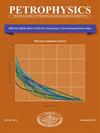Effect of Chelating Agents on Tight Sandstone Formation Mineralogy During Sandstone Acidizing
IF 0.7
4区 工程技术
Q3 ENGINEERING, PETROLEUM
引用次数: 0
Abstract
Dissolution of the wellbore damage is the main target of sandstone acidizing. The presence of minerals like clays, feldspar, zeolites, and alumino-silicates makes acidizing a challenging task because they may form undesired products (precipitates) when reacted with mud acid. Secondary and tertiary reactions are responsible for the formation of these products. To avoid the formation of precipitates, which are formed due to the reaction of conventional acids with minerals, chelating agents were utilized in this research paper. The chelating agents provide the advantage of deep penetration and slow reaction rate. The chelating agents HEDTA (hydroxyethylethylenediaminetriacetic acid), GLDA (tetrasodium glutamate diacetate), and EDTA (ethylethylenediaminetriacetic acid) were allowed to react with Colton sandstone formation under 1,000 psi confining pressure and 180°F temperature. The reacted core samples were tested for different analyses to analyze the effect of chelates on the core sample properties. The analyses performed are elemental analysis, mineral analysis, grain-size analysis, and porosity, particle, and density analysis. In elemental analysis, due to the tight nature of the Colton sandstone, the chelates were not that effective. From mineral analysis, HEDTA proved to be effective in the dissolution of quartz, ankerite, orthoclase, and calcite compared to GLDA and EDTA. According to a porosity analysis investigation, HEDTA produced the most additional pore spaces when reacted with the Colton sandstone formation.砂岩酸化过程中螯合剂对致密砂岩地层矿物学的影响
井眼损伤的溶解是砂岩酸化的主要目标。粘土、长石、沸石和铝硅酸盐等矿物的存在使酸化成为一项具有挑战性的任务,因为它们在与泥浆酸反应时可能形成不希望的产物(沉淀物)。二级和三级反应是形成这些产物的原因。为了避免常规酸与矿物质反应产生沉淀,本文采用了螯合剂。该螯合剂具有渗透深、反应速度慢的优点。螯合剂HEDTA(羟乙基乙二胺三乙酸)、GLDA(谷氨酸四钠二乙酸)和EDTA(乙基乙二胺三乙酸)在1000 psi围压和180°F温度下与Colton砂岩地层发生反应。对反应后的岩心样品进行了不同的分析,分析了螯合剂对岩心样品性质的影响。所进行的分析包括元素分析、矿物分析、粒度分析、孔隙度、颗粒和密度分析。在元素分析中,由于科尔顿砂岩的致密性,螯合剂不是那么有效。从矿物分析来看,与GLDA和EDTA相比,HEDTA在石英、针铁矿、正长石和方解石的溶解中被证明是有效的。根据一项孔隙度分析调查,当HEDTA与Colton砂岩地层发生反应时,产生的额外孔隙空间最多。
本文章由计算机程序翻译,如有差异,请以英文原文为准。
求助全文
约1分钟内获得全文
求助全文
来源期刊

Petrophysics
地学-地球化学与地球物理
CiteScore
1.80
自引率
11.10%
发文量
40
审稿时长
>12 weeks
期刊介绍:
Petrophysics contains original contributions on theoretical and applied aspects of formation evaluation, including both open hole and cased hole well logging, core analysis and formation testing.
 求助内容:
求助内容: 应助结果提醒方式:
应助结果提醒方式:


